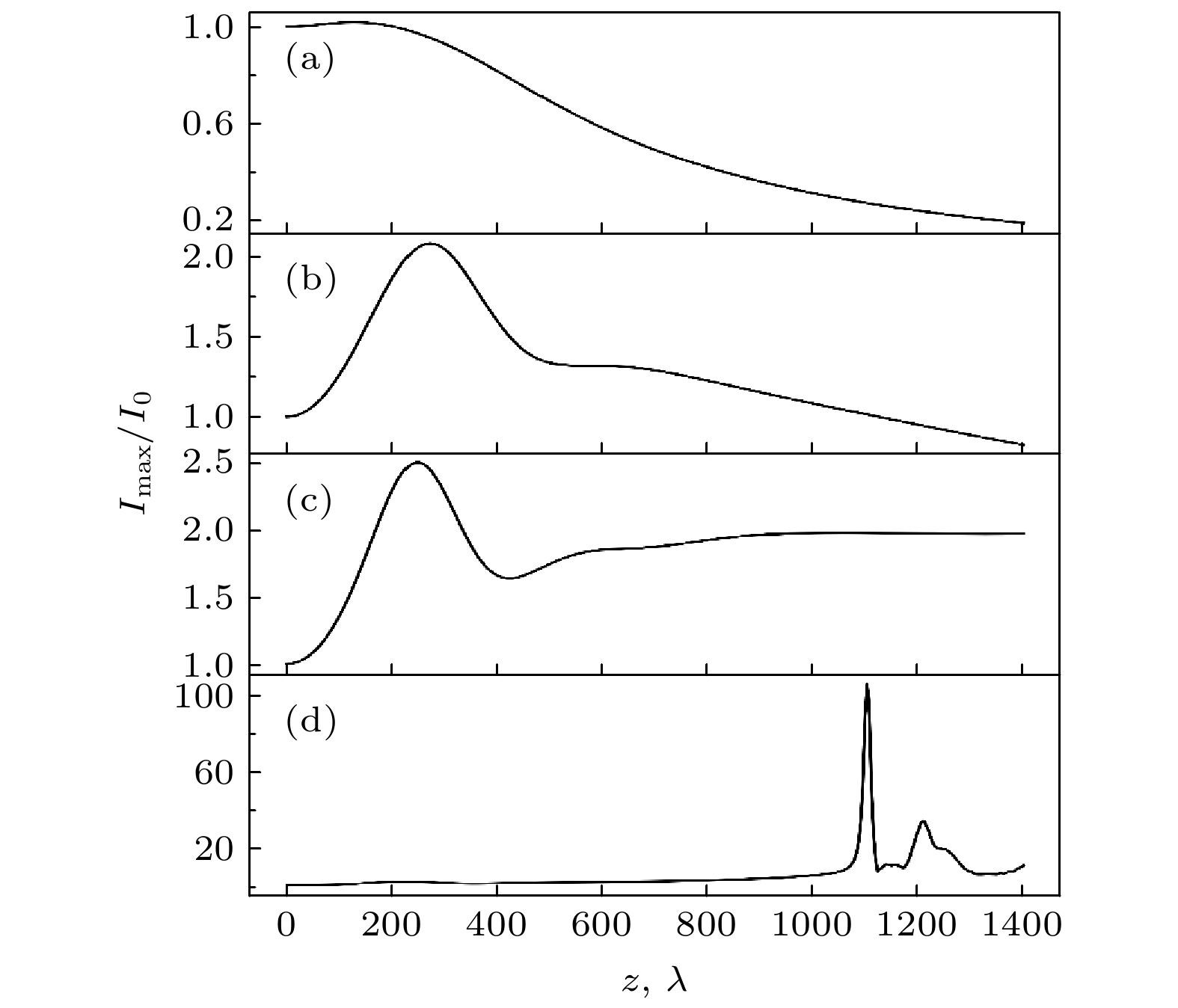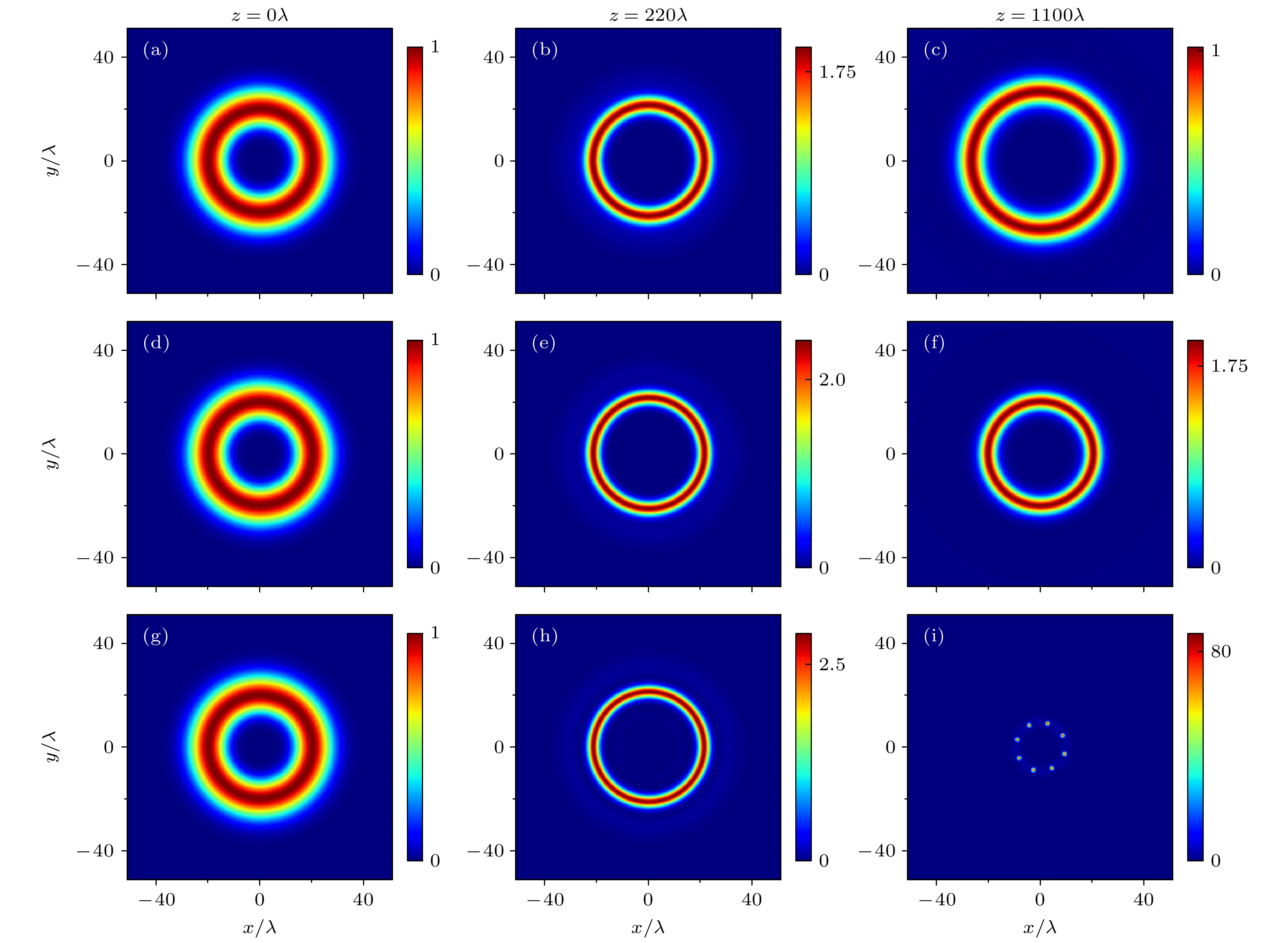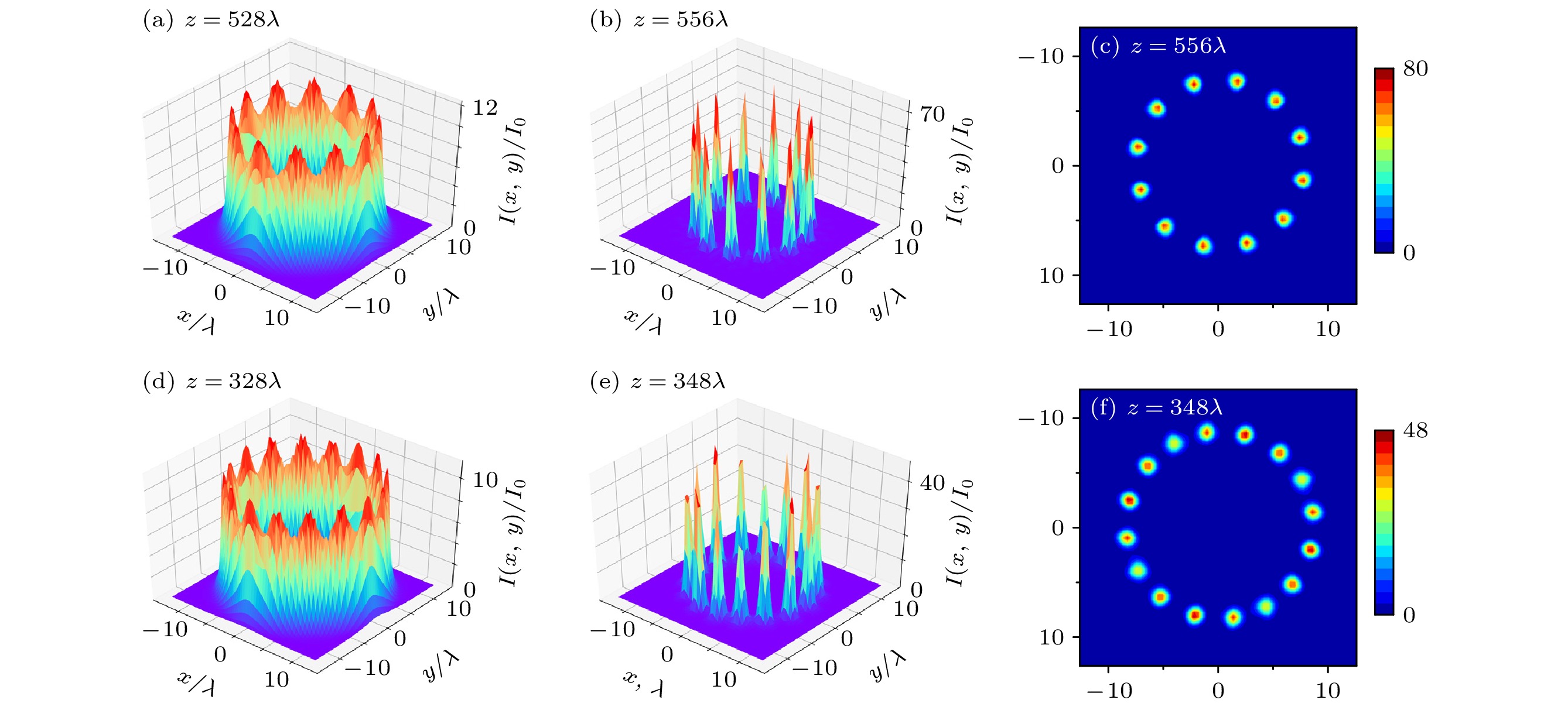-
We have studied the self-focusing and filamentation of vortex laser beams propagating in underdense plasmas with different values of the topological charge and initial laser powers. The self-focusing dynamics of vortex laser beams is closely related to the topological charge, which has attracted widespread attention. Based on the paraxial approximation of the Helmholtz equation, the steady-state solution of vortex beams propagating in underdense plasmas is deduced, and the expression for critical power of vortex laser beams is obtained. Furthermore, using the split-step Fourier method to solve the wave equation, we analyze the numerical images of vortex laser beams propagating in underdense plasma under different parameters. The simulation results show that the critical power for self-focusing is positively correlated with the topological charge of vortex laser beams. When the initial laser power is high enough, the vortex laser beam will first be focused into a thin ring, and then the modulation amplitude increases continuously, which eventually leads to the ring structure breaking into filaments. The number of filaments has an integer multiple relationship with the topological charge. In the process of filamentation, the radius and the maximum light intensity of vortex laser beam both change drastically. After the filamentation process is completed, the vortex laser beam continues to propagate with a new topological type. We further increase the incident laser power and find that the number of filaments of the vortex laser beam increases. The increased number of filaments is the value of its topological charge at each time. With the development of filament instability, higher-order modulation instability can be excited in the later stage, and the intensity of filaments will exhibit angular modulation. Our results show that in compared with the standard Gaussian beam, the propagation behavior of vortex laser beams in underdense plasmas is much more stable under the same power, wavelength and plasma parameters. The propagation characteristics of vortex laser beams are helpful to the theoretical and experimental study of stimulated backward Raman amplification of ultra-strong vortex beam in underdense plasmas.
-
Keywords:
- vortex beam /
- self focusing /
- filament instability /
- nonlinear propagation
[1] Max C E 1976 Phys.Fluids 19 74
 Google Scholar
Google Scholar
[2] Berger R L, Lasinski B F, Kaiser T B, Williams E A, Langdon A B, Cohen B I 1993 Phys. Fluids B 5 2243
 Google Scholar
Google Scholar
[3] Pukhov A, Mayer-ter-vehn J 1996 Phys. Rev. Lett. 76 3975
 Google Scholar
Google Scholar
[4] Kruglov V I, Logvin Yu A, Volkov V M 1992 J. Mod. Opt. 39 2277
 Google Scholar
Google Scholar
[5] Feit M D, Fleck J A 1988 J. Opt. Soc. Am. B 5 633
 Google Scholar
Google Scholar
[6] Vuong L T, Grow T D, Ishaaya A 2006 Phys. Rev. Lett. 96 133901
 Google Scholar
Google Scholar
[7] Wang W P, Shen B F, Zhang X M, Zhang L G, Shi Y, Xu Z Z 2015 Sci. Rep. 5 8274
 Google Scholar
Google Scholar
[8] Zhang X M, Shen B F, Shi Y, Wang X F, Zhang L G, Wang W P, Xu J C, Yi L Q, Xu Z Z 2015 Phys. Rev. Lett. 114 173901
 Google Scholar
Google Scholar
[9] Vieira1 J, Trines R M, Alves E P, Fonseca R A, Mendonca, Bingham R, Norreys P, Silva L O 2016 Nat. Comm. 7 10371
 Google Scholar
Google Scholar
[10] Cohen B I, Lasinski B F, Langdon A B, Cummings J C 1991 Phys. Fluids B 3 766
 Google Scholar
Google Scholar
[11] Sodha M S, Sharma A 2007 Phys. Plasmas 14 044501
 Google Scholar
Google Scholar
[12] Akhmanov S A, Sukhorukov A P, Khokhlov R V 1968 Sov. Phys. Usp. 10 609
 Google Scholar
Google Scholar
[13] Sodha M S, Ghatak A K, Tripathi V K 1976 Prog. Opt. 13 171
 Google Scholar
Google Scholar
[14] Sodha M S, Mishra S K, Misra S 2009 Laser Part. Beams 27 57
 Google Scholar
Google Scholar
[15] Thakur A, Berakdar J 2010 Opt. Express 18 27691
 Google Scholar
Google Scholar
[16] Dávila Romero L C, Andrews D L, Babiker M 2002 J. Opt. B 4 S66
 Google Scholar
Google Scholar
[17] Purohit G, Rawat P, Gauniyal R 2016 Phys. Plasmas 23 013103
 Google Scholar
Google Scholar
[18] Lam J F, Lippmann B 1977 Phys. Fluids 20 1176
 Google Scholar
Google Scholar
[19] Feit M D, Fleck J A 1978 Appl. Opt. 17 3990
 Google Scholar
Google Scholar
[20] 文双春, 范滇元 2000 49 460
 Google Scholar
Google Scholar
Wen S C, Fan D Y 2000 Acta Phys. Sin. 49 460
 Google Scholar
Google Scholar
[21] Firth W J, Skryabin D V 1997 Phys. Rev. Lett. 79 2450
 Google Scholar
Google Scholar
[22] Bigelow M S, Zerom P, Boyd R W 2004 Phys. Rev. Lett. 92 083902
 Google Scholar
Google Scholar
[23] Malkin V M, Shvets G, Fisch N J 1999 Phys. Rev. Lett. 82 4448
 Google Scholar
Google Scholar
-
图 2 不同功率下
${\text{L}}G_0^4$ 涡旋光束峰值光强随传输距离变化的模拟对比图 (a)$P = P_{\rm{c}}^{(4)} ;$ (b)$P = 5 P_{\rm{c}}^{(4)} ;$ (c)$P = 6 P_{\rm{c}}^{(4)} ;$ (d)$P = 7 P_{\rm{c}}^{(4)}$ Figure 2. Normalized maximum intensity of vortex beams with different input powers versus propagation distance for
${m}=4$ : (a)$P = P_{\rm{c}}^{(4)} ;$ (b)$P = 5 P_{\rm{c}}^{(4)} ;$ (c)$P = 6 P_{\rm{c}}^{(4)} ;$ (d)$P = $ $ 7 P_{\rm{c}}^{(4)}$ 图 3 不同功率下涡旋光束传输至不同位置的光强横向分布图 (a)—(c)
$P = 5 P_{\mathrm{c}}^{(4)}$ ; (d)—(f)$P = 6 P_{\mathrm{c}}^{(4)}$ ; (g)—(i)$P = $ $ 7 P_{\mathrm{c}}^{(4)}$ Figure 3. Intensity distribution of vortex beams with different input powers at different positions: (a)–(c)
$P = 5 P_{\mathrm{c}}^{(4)}$ ; (d)–(f)$P = 6 P_{\mathrm{c}}^{(4)}$ ; (g)–(i)$P = 7 P_{\mathrm{c}}^{(4)}$ . The initial parameters are the same as in Fig. 1图 5
$P=10 P_{\rm{c}}^{(4)}$ ,$15 P_{\rm{c}}^{(4)}$ 两组参数下${\text{L}}{\rm{G}}_0^4$ 涡旋光束成丝现象的模拟结果 (a)—(c)$P = 10 P_{\mathrm{c}}^{(4)}$ ; (d)—(f)$P = 15 P_{\mathrm{c}}^{(4)}$ Figure 5. Filament formation of the vortex beams that has different high powers: (a)–(c)
$P = 10 P_{\mathrm{c}}^{(4)}$ ; (d)–(f)$P = 15 P_{\mathrm{c}}^{(4)}$ , where${m}=4$ are taken图 6
${\text{L}}{\rm{G}}_0^2$ 模、${\text{L}}{\rm{G}}_0^6$ 模涡旋光束成丝现象的模拟结果对比图 (a)—(c)$m=2, P = 5 P_{\mathrm{c}}^{(2)} $ ; (d)—(f)$m=6, P = 7 P_{\mathrm{c}}^{(7)} $ Figure 6. Evolution of vortex beams with different values of the topological charge when the initial power is just enough to generate filaments: (a)–(c)
$m=2, P = 5 P_{\mathrm{c}}^{(2)} $ ; (d)–(f)$m=6, P = 7 P_{\mathrm{c}}^{(7)} $ -
[1] Max C E 1976 Phys.Fluids 19 74
 Google Scholar
Google Scholar
[2] Berger R L, Lasinski B F, Kaiser T B, Williams E A, Langdon A B, Cohen B I 1993 Phys. Fluids B 5 2243
 Google Scholar
Google Scholar
[3] Pukhov A, Mayer-ter-vehn J 1996 Phys. Rev. Lett. 76 3975
 Google Scholar
Google Scholar
[4] Kruglov V I, Logvin Yu A, Volkov V M 1992 J. Mod. Opt. 39 2277
 Google Scholar
Google Scholar
[5] Feit M D, Fleck J A 1988 J. Opt. Soc. Am. B 5 633
 Google Scholar
Google Scholar
[6] Vuong L T, Grow T D, Ishaaya A 2006 Phys. Rev. Lett. 96 133901
 Google Scholar
Google Scholar
[7] Wang W P, Shen B F, Zhang X M, Zhang L G, Shi Y, Xu Z Z 2015 Sci. Rep. 5 8274
 Google Scholar
Google Scholar
[8] Zhang X M, Shen B F, Shi Y, Wang X F, Zhang L G, Wang W P, Xu J C, Yi L Q, Xu Z Z 2015 Phys. Rev. Lett. 114 173901
 Google Scholar
Google Scholar
[9] Vieira1 J, Trines R M, Alves E P, Fonseca R A, Mendonca, Bingham R, Norreys P, Silva L O 2016 Nat. Comm. 7 10371
 Google Scholar
Google Scholar
[10] Cohen B I, Lasinski B F, Langdon A B, Cummings J C 1991 Phys. Fluids B 3 766
 Google Scholar
Google Scholar
[11] Sodha M S, Sharma A 2007 Phys. Plasmas 14 044501
 Google Scholar
Google Scholar
[12] Akhmanov S A, Sukhorukov A P, Khokhlov R V 1968 Sov. Phys. Usp. 10 609
 Google Scholar
Google Scholar
[13] Sodha M S, Ghatak A K, Tripathi V K 1976 Prog. Opt. 13 171
 Google Scholar
Google Scholar
[14] Sodha M S, Mishra S K, Misra S 2009 Laser Part. Beams 27 57
 Google Scholar
Google Scholar
[15] Thakur A, Berakdar J 2010 Opt. Express 18 27691
 Google Scholar
Google Scholar
[16] Dávila Romero L C, Andrews D L, Babiker M 2002 J. Opt. B 4 S66
 Google Scholar
Google Scholar
[17] Purohit G, Rawat P, Gauniyal R 2016 Phys. Plasmas 23 013103
 Google Scholar
Google Scholar
[18] Lam J F, Lippmann B 1977 Phys. Fluids 20 1176
 Google Scholar
Google Scholar
[19] Feit M D, Fleck J A 1978 Appl. Opt. 17 3990
 Google Scholar
Google Scholar
[20] 文双春, 范滇元 2000 49 460
 Google Scholar
Google Scholar
Wen S C, Fan D Y 2000 Acta Phys. Sin. 49 460
 Google Scholar
Google Scholar
[21] Firth W J, Skryabin D V 1997 Phys. Rev. Lett. 79 2450
 Google Scholar
Google Scholar
[22] Bigelow M S, Zerom P, Boyd R W 2004 Phys. Rev. Lett. 92 083902
 Google Scholar
Google Scholar
[23] Malkin V M, Shvets G, Fisch N J 1999 Phys. Rev. Lett. 82 4448
 Google Scholar
Google Scholar
Catalog
Metrics
- Abstract views: 5981
- PDF Downloads: 142
- Cited By: 0

















 DownLoad:
DownLoad:









































